When you think of Japanese food, typically what comes to mind are things like sushi, ramen, udon, and perhaps some sort of donburi like katsudon (breaded pork cutlet on rice).
These are all mouthwatering but if you travel to Japan or live here, there is one dish you must absolutely try —okonomiyaki.
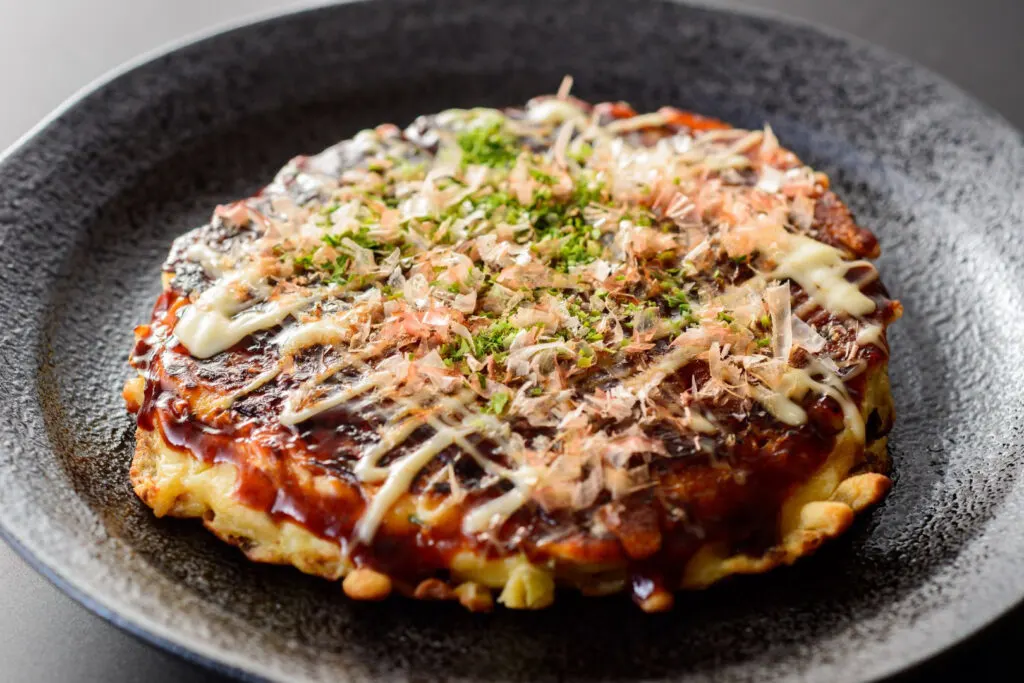
Table of Contents
What is Okonomiyaki?
Okonomiyaki (お好み焼き, おこのみやき) is a Japanese teppanyaki dish that is most commonly found in western Japan. Some people liken okonomiyaki to a savory pancake as it is similar in shape, has toppings, and is cut into pieces when eating.
However, unlike pancakes, one okonomiyaki alone is incredibly filling. Sometimes you can even share a single okonomiyaki between two people!
Regional Variations
There are two main styles of okonomiyaki, which are classified according to the region they’re from — Kansai and Hiroshima.
There’s almost a competition between the two and throughout my time in Japan I’ve been asked multiple times which style I prefer. I used to be a fan of Hiroshima style when I lived in that area but now that I’m in Kansai, I’ve grown to really like Kansai style as well.
Kansai-style Okonomiyaki
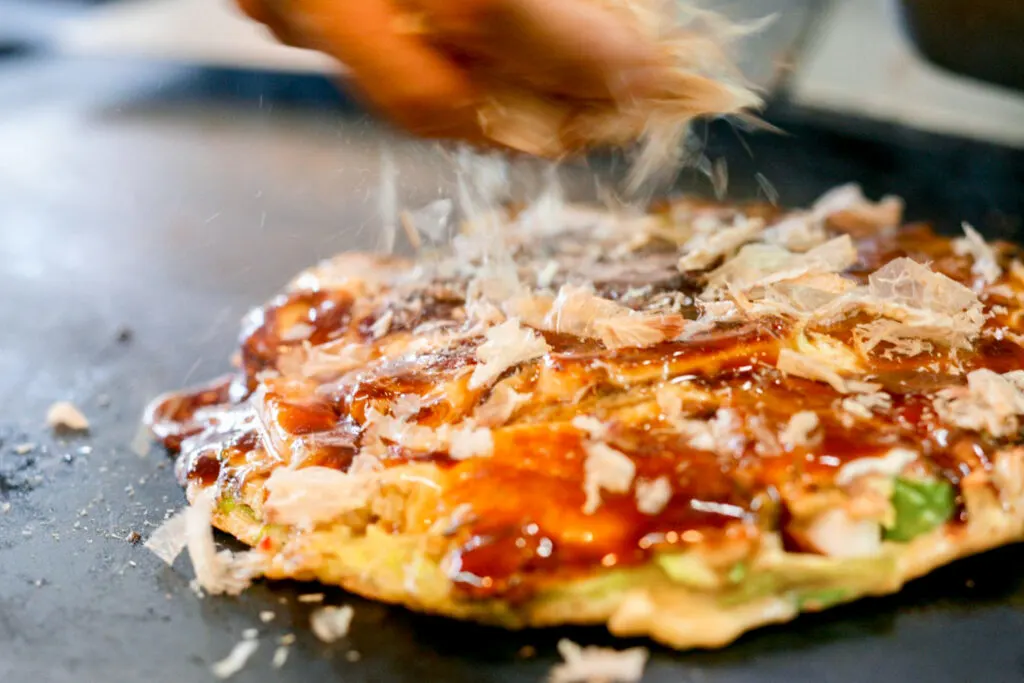
Similar to a pancake, Kansai-style okonomiyaki (関西風お好み焼き, かんさいふう・おこのみやき), also known as Osaka-style okonomiyaki, contains several ingredients mixed together in a bowl and then fried on a hot plate or frying pan.
One key ingredient is okonomiyaki flour, which consists of flour, dashi, and other seasonings. This is mixed with water before adding shredded cabbage and egg to it and mixing it all once again. The batter is then fried and flipped so it’s cooked on both sides.
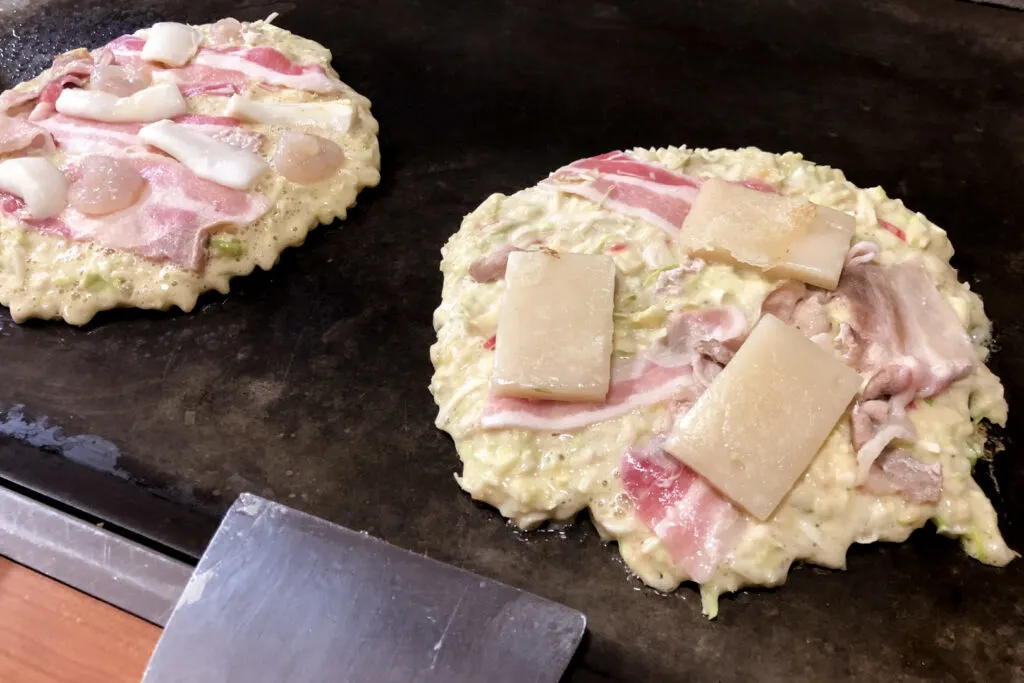
Once it’s ready, it’s topped with sweet and savory okonomiyaki sauce, mayonnaise, and aonori seaweed powder. When you bite in, you’ll discover that it has a fluffy texture, which is sweet from the batter but also has some crunch and salty flavor from the other ingredients.
This is the most basic form of Kansai-style okonomiyaki, and one that’s usually made at home since it’s so simple. However, it’s also common to add ingredients such as slices of pork, dried bonito fish flakes (katsuobushi, 鰹節, かつおぶし), thinly sliced red pickled ginger (beni shōga, 紅しょうが, べにしょうが), green onions, and bits of tempura batter (tenkasu, 天かす, てんかす also known as agedama, 揚げ玉, あげだま).
Although the exact origins of okonomiyaki are a bit fuzzy, many believe that Kansai style evolved from a Japanese sweet called funoyaki (麩の焼き, ふのやき) in the Momoyama period (1574-1600), which resembles a rolled crepe. This then evolved into monjayaki (もんじゃ焼き, もんじゃやき) in the Meiji period (1868-1912), a fried savory pancake dish, before becoming the Kansai style of okonomiyaki we know today.
Hiroshima-style Okonomiyaki

Hiroshima-style okonomiyaki (広島風お好み焼き, ひろしまふう・おこのみやき), is considerably more difficult to make than Kansai style as it is layered rather than mixed together. Hiroshima style also has crispy yakisoba, or fried noodles, inside of it (one reason why it’s my favorite style). The batter and cabbage differ as well — Hiroshima style uses less batter and more thinly sliced cabbage as flour was scarce after WWII.
Like when making a crepe, a ladle of batter for Hiroshima-style okonomiyaki is poured onto a griddle and then swirled into a thin circle. Ingredients such as cabbage, beansprouts, tenkasu, green onions, and slices of pork are layered on top. More batter is poured on top and when the batter on the bottom is firm, everything is flipped. It takes quite some skill to do this successfully!
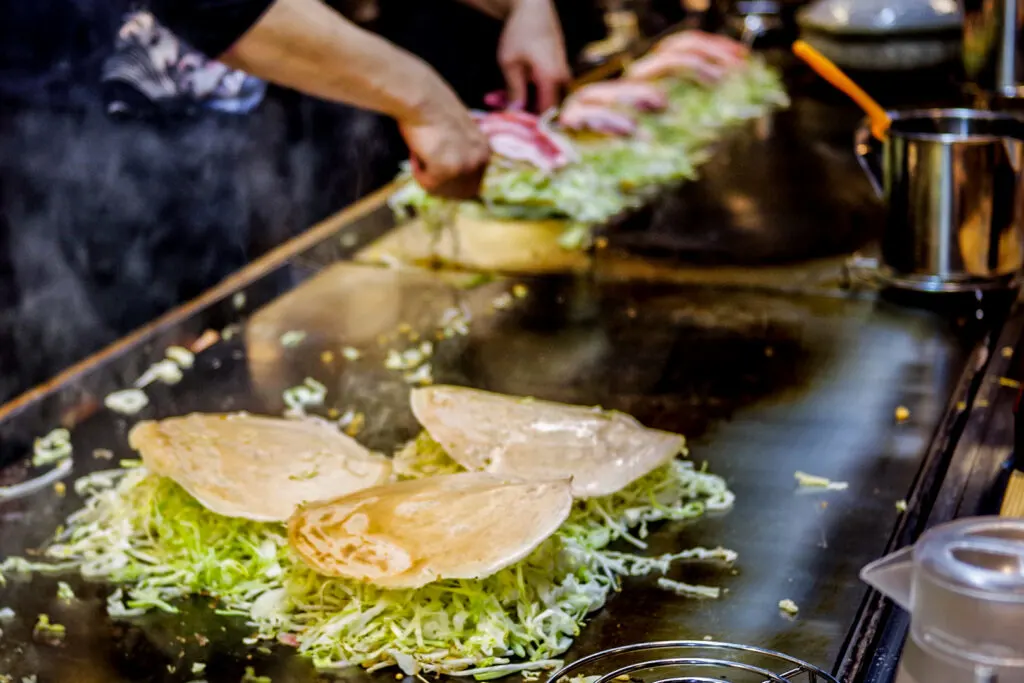
While the okonomiyaki-in-progress continues to cook, yakisoba is cooked next to it. Once the cabbage is tender, everything is moved on top of the yakisoba. An egg is then cracked on the teppan, the yolk roughly broken up using two hera and, once fried, topped with the okonomiyaki and flipped one last time. It’s quite the show and fun to watch being made.
Just like Kansai style, okonomiyaki sauce and aonori seaweed (青のり, あおのり) are generously spread on top. However, the okonomiyaki sauce for Hiroshima style tends to be sweeter than Kansai style. Mayonnaise also isn’t traditionally used in Hiroshima-style okonomiyaki, although it’s becoming more common.
Hiroshima okonomiyaki was born following the atomic bombing of Hiroshima city in 1945. As food was scarce, locals began to use iron plates to cook a traditional cheap snack called issen yōshoku (銭洋食, いっせん・ようしょく), which consists of a flour and water batter that is fried, topped with green onions or bonito (dried fish flakes), and then folded in half like a soft taco.
They gradually began to add cabbage, eggs, slices of pork, and fried soba noodles to create a filling dish that is now known as Hiroshima-style okonomiyaki. Similarly, people in Kansai also made their own style of okonomiyaki as a staple meal more often following the war due to it being both cheap to make and filling.
These sad origins are why you’ll see that many long-established okonomiyaki restaurants in Hiroshima are named after women (ending in -chan or ちゃん, a suffix used for children and young women). As many men died during the war, their widows started these shops as a means of survival.
Okonomiyaki Toppings
One of the best parts about okonomiyaki, regardless of the style, is that you can also add a smorgasbord of toppings to it (hence the name okonomiyaki, which literally means an “as you like it” (okonomi) cooked or fried dish (yaki), as you can customize the dish to your liking).

Some of the more popular toppings include:
- Mochi (もち)
- Cheese (チーズ)
- Chopped mixed seafood, such as octopus, squid, and scallops (シーフードミックス)
- Kimchi (キムチ)
- Squid (イカ)
- Shrimp (えび)
- Beansprouts (もやし)
My favorite combination is kimchi and cheese, my husband’s is seafood, while my daughter’s is corn and cheese.
If you have trouble deciding what toppings to get at an okonomiyaki restaurant, menus usually offer different popular combinations to select from to make it easier for customers. You can also ask them to omit ingredients as well.
How to Eat Okonomiyaki
When eating okonomiyaki in a restaurant, use one of the provided spatulas called hera (へら) to cut the okonomiyaki into bite-sized pieces.
Then you can eat it directly off of the hot plate or place a piece onto a small plate and eat it from there using chopsticks. Eating it straight from the hot plate ensures that it stays warm and crispy but transferring it piece by piece to a plate allows it to cool off.

You can also add more okonomiyaki sauce or mayonnaise to it if you wish.
If you’re trying okonomiyaki for the first time with another person, I recommend sharing a basic one initially. As it’s quite filling, you may not need one for each person. And if you decide to order another, you can try something different, which is another reason why okonomiyaki is a great dish to share.
Where to Eat Okonomiyaki
You can find okonomiyaki restaurants throughout Japan and is a common dish at festivals, although outside of the Chugoku region, it’s far easier to find places that serve Kansai style rather than Hiroshima style.
Kansai-style restaurants usually provide you with the ingredients and the teppan (griddle) to make the okonomiyaki yourself. This might be a strange concept for some visitors to Japan —after all, one of the draws of eating out is having someone else cook your meal for you— but like yakiniku (BBQ meat), cooking it yourself is part of the experience.
Don’t worry, the restaurant staff are always happy to help when it comes to making it, including flipping or even cooking the okonomiyaki for you, and sometimes there are instructions with illustrations as well.

Although the Kansai region consists of several regions in west Japan, Kansai-style okonomiyaki is commonly associated with Osaka. You can find restaurants and stalls that serve this style of okonomiyaki anywhere in Osaka really but for the best, head to Dotonbori, which is known for kuidaore (食い倒れ, くいだおれ) — you end up eating so much that you’ll end up bankrupt. Truly heaven for a foodie.
I recommend checking out two chain restaurants there — CHIBO, which offers both traditional and unique okonomiyaki as well as teppanyaki dishes, and Okonomiyaki Fugetsu. For those looking for something more local, Kiji (きじ) is a Michelin-starred okonomiyaki restaurant. Fukutaro (福太郎) in Namba is also popular.
If you want to try Hiroshima style (and you absolutely should), then head to Hiroshima city for the most authentic experience. There are hundreds of okonomiyaki restaurants in Hiroshima city. In fact, Hondori, the main shopping street in Hiroshima city, has an okonomiyaki “village” called Okonomimura (お好み村、おこのみむら), which is a building filled with okonomiyaki stalls. I say stalls because they fit maybe 10 people at most. This leads to the most popular ones having long lines and it can be cramped at times but there is no better experience.
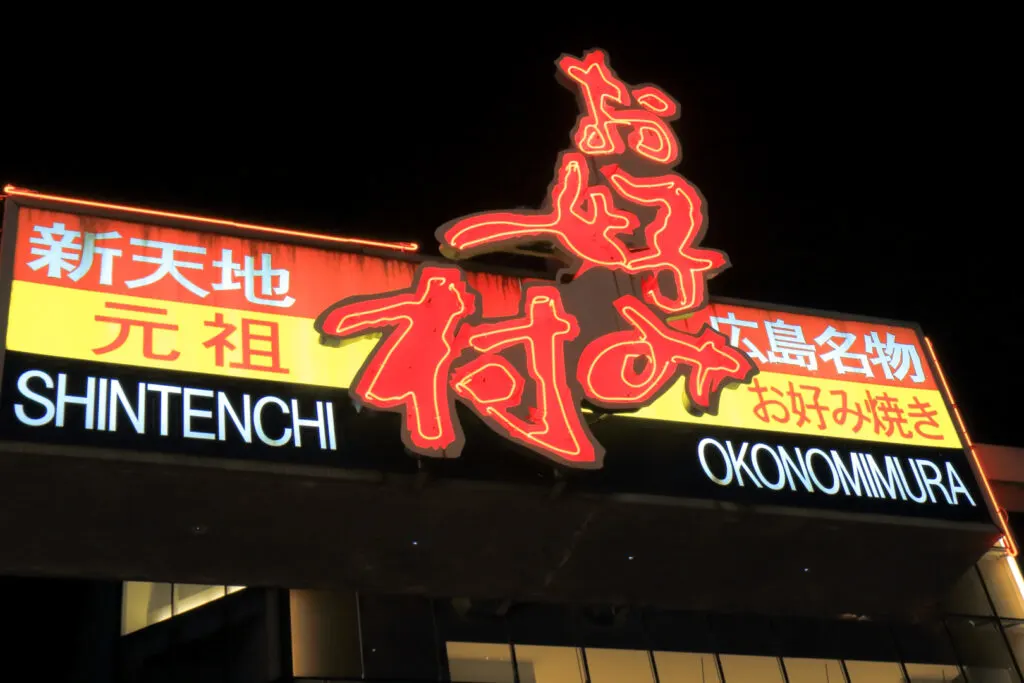
If you don’t feel like going to Hondori or you’re just making a brief stop at Hiroshima station, you can also enjoy okonomiyaki at various restaurants on the second floor of the ASSE mall, or the Hiroshima Okonomi Monogatari Ekimae Hiroba.
Pin me for later
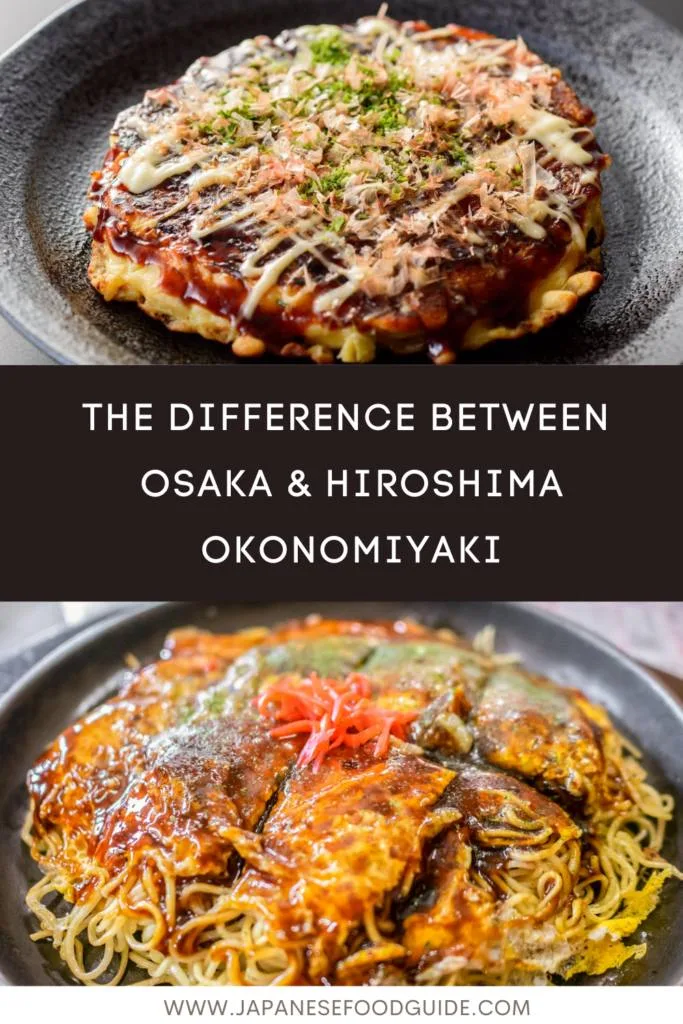
Kay is a Canadian freelance translator and writer who has been in Japan for more than a decade. Having lived in the Chugoku, Kanto, and now the Kansai regions, she hopes to share their various local cuisine on JFG.
She also writes about her experiences being a mother in Japan on her website, Tiny Tot in Tokyo.
